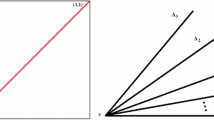Abstract
It is shown that, for any 1 ≤ n < ∞, there exist four maps of the n-dimensional cube to itself such that the limit of any inverse sequence of n-cubes is the limit of some sequence with only these four bonding maps. A universal continuum in the class of all limits of sequences of n-cubes is constructed as the limit of an inverse sequence of n-cubes with one bonding map. All compact sets of trivial shape are represented by using only three maps of the Hilbert cube to itself. Two maps of the closed interval to itself such that any Knaster continuum can be obtained as the limit of an inverse sequence with only these two bonding maps are constructed.
Similar content being viewed by others
REFERENCES
G. W. Henderson, “The pseudo-arc as an inverse limit with one binding map,” Duke Math. J., 31(1964), no. 3, 421–425.
W. S. Mahavier, “A chainable continuum not homeomorphic to an inverse limit on [0,1] with only one bonding map,” Proc. Amer. Math. Soc., 18 (1967), 284–286.
J. W. Rogers, Jr., “Continua not an inverse limit with a single bonding map on a polyhedron,” Proc.Amer. Math. Soc., 21 (1969), no. 2, 281–283.
D. S. Marsh, “A chainable continuum not homeomorphic to an inverse limit on [0, 1] with only one bonding map,” Colloq. Math., 43 (1980), 75–80.
M. Brown, “Some applications of an approximation theorem for inverse limits,” Proc. Amer. Math.Soc., 11 (1960), 478–483.
R. F. Jolly and J. T. Rogers, Jr., “Inverse limit spaces denned by only finitely many distinct bonding maps,” Fund. Math., 68 (1970), 117–120.
R. M. Schori, “A universal snake-like continuum,” Proc. Amer. Math. Soc., 16 (1965), no. 6, 1313–1316.
B. A. Pasynkov, “On universal compact spaces,” Uspekhi Mat. Nauk [Russian Math. Surveys], 21 (1966), no. 4, 91–100.
M. C. McCord, “Universal P -like compacta,” Michigan Math. J., 13 (1966), 71–85.
S. Mardešić and J. Segal, “ε-mappings onto polyhedra,” Trans. Amer. Math. Soc., 109 (1963), 146–164.
I. Rubanov, “A characterization of shapes of compact spaces by spectra of nerves of covers,” Sib.Matem. Zhurn., 20 (1979), no. 1, 128–140.
S. Mardešić, “Decreasing sequences of cubes and compacta of trivial shape,” Gen. Topol. Appl., 2 (1972), no. 1, 17–23.
J. Keesling, “Shape theory and topological groups,” Lecture Notes in Math., 378 (1974), 233–242.
M. C. McCord, “Inverse limit sequences with covering maps,” Trans. Amer. Math. Soc., 114 (1965),197–209.
J. W. Rogers, Jr., “On mapping indecomposable continua onto certain chainable indecomposable continua,” Proc. Amer. Math. Soc., 25 (1970), 449–456.
W. Debski, “On topological types of the simplest indecomposable continua,” Colloq. Math., 49 (1985), 203–211.
W. T. Watkins, “Homeomorphic classification of certain inverse limit spaces with open bonding maps,” Pacific J. Math., 103 (1982), no. 2, 589–601.
G. A. Gal'perin and A. N. Zemlyakov, Mathematical Billiards [in Russian], Nauka, Moscow, 1990.
Author information
Authors and Affiliations
Rights and permissions
About this article
Cite this article
Frolkina, O.D. Inverse Spectra with Two and Three Maps. Mathematical Notes 73, 706–710 (2003). https://doi.org/10.1023/A:1024021007136
Issue Date:
DOI: https://doi.org/10.1023/A:1024021007136



